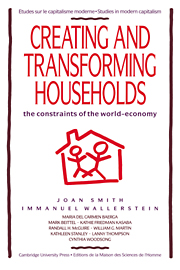Book contents
- Frontmatter
- Contents
- Preface
- I INTRODUCTION
- II THE UNITED STATES
- Introduction
- 1 The Detroit story: the crucible of Fordism
- 2 New York City: the underside of the world's capital
- 3 Binghamton: the secrets of a backwater
- 4 Puerto Rico: from colony to colony
- III MEXICO
- IV SOUTHERN AFRICA
- V CONCLUSION
- A postscript on method
- References
- Index
- Studies in Modern Capitalism
Introduction
Published online by Cambridge University Press: 07 June 2010
- Frontmatter
- Contents
- Preface
- I INTRODUCTION
- II THE UNITED STATES
- Introduction
- 1 The Detroit story: the crucible of Fordism
- 2 New York City: the underside of the world's capital
- 3 Binghamton: the secrets of a backwater
- 4 Puerto Rico: from colony to colony
- III MEXICO
- IV SOUTHERN AFRICA
- V CONCLUSION
- A postscript on method
- References
- Index
- Studies in Modern Capitalism
Summary
For the United States, the period after the Civil War witnessed a spectacular and steady rise in economic wealth. These were also the years during which the US solidified its central role in the worldsystem, strengthened its military power, and improved its political standing.
At the point where the hegemonic role of Great Britain in the capitalist world-economy began to wane, the United States entered into a long multifaceted competition with Germany to be the successor hegemonic power, a competition that was finally resolved in 1945. From 1945 to circa 1970 the US stood as the unquestioned hegemonic power. After 1967/73, with the onset of another long Kondratieff B-phase of stagnation in the world-economy, the relative position of the US began to be eroded. This has had some relatively immediate and negative effects on the level of economic well-being in the US.
The rise to hegemony of the US, in the period 1945-70, was based in large part on its “efficiency” in all spheres of production. In terms of the workforce this meant a steady and significant expansion both of the waged labor force and of the level of real wages. In terms of household structures, this meant, as we shall see, considerable transformations.
The biggest single change in the structure of the workforce over this period was the virtual disappearance of the agricultural sector as a significant user of labor. This went along with a spectacular expansion of the percentage of labor employed in the service sector.
- Type
- Chapter
- Information
- Creating and Transforming HouseholdsThe Constraints of the World-Economy, pp. 27 - 32Publisher: Cambridge University PressPrint publication year: 1992



